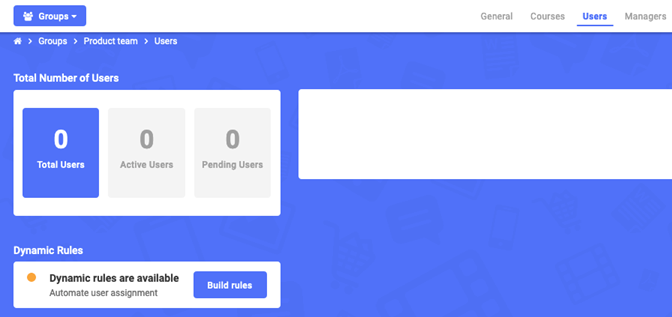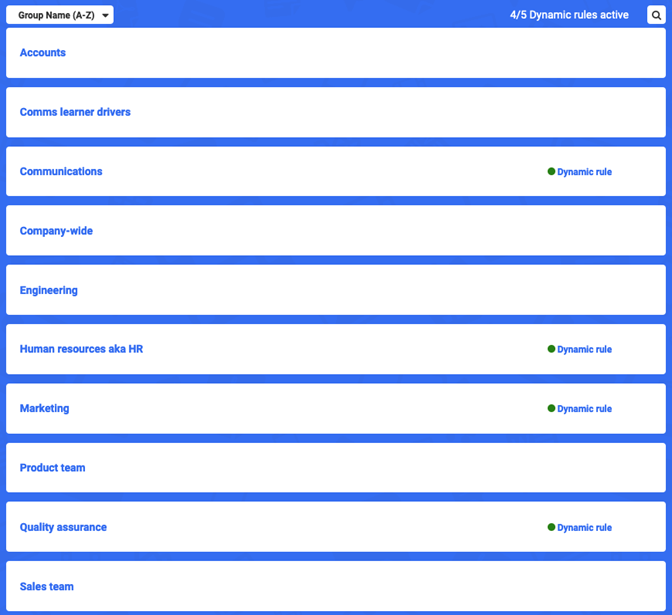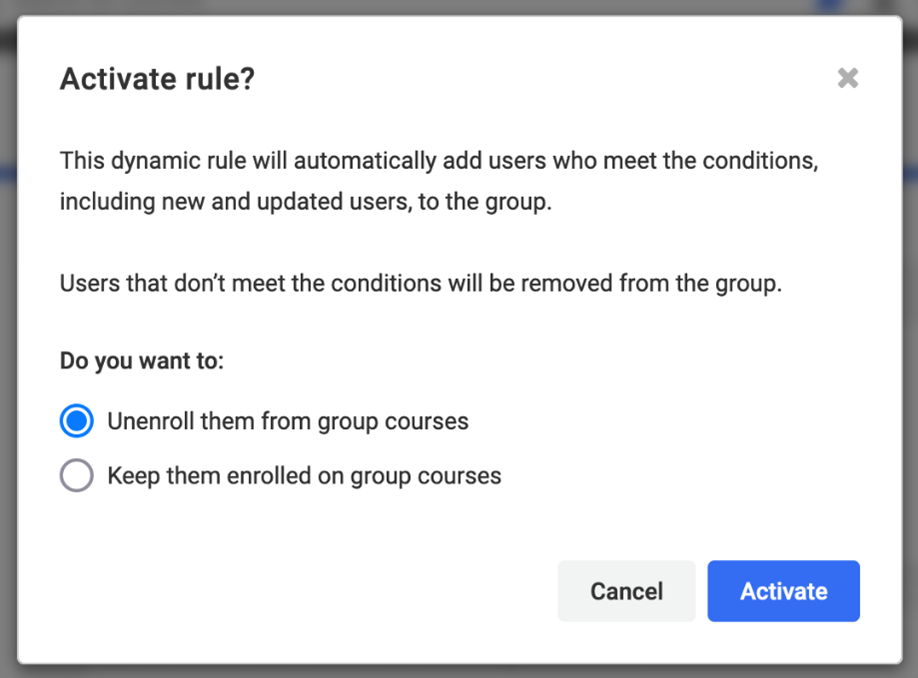Admins: Dynamic rules: overview
Automate the
routine work of sorting learners
If you don't see the feature when you view Users within Groups, contact your customer support team to discuss using dynamic rules for your organization's needs.
Dynamic rule features
The dynamic rule feature lets you filter users into groups as soon as you create them in Safety Made Simple. You create filtering rules based on:
- your user's email domain
- the date you create a user, or that they sign up or accept an invite
- your custom user data
- "all users", with no internal rules required
This "all users" group can provide a foundation for rules to apply across your organization.
While building a rule you can:
- Save a draft, to return to later
- Preview the rule with a test run, before committing to starting the rule
Once you run a rule, the rule applies to your existing users, and your new and updated users. It runs on your portal from that point onward, until you deactivate it.
A new rule takes a few minutes to start, as it reviews all your existing users' conditions. When established, the rule runs continuously in the background.
You can preview a rule before running it. A preview:
- shows the number of users who match the criteria
- lets you download a CSV copy of those users, as a reference
If the rule preview shows a very different number of users from what you expected, you can revise the rule before running it.
 Note: Dynamic rules run on the criteria you set, with the fields you choose: the rules don't "look" at other user data. You can preview what the rule does, to find out how many users the rule affects.
Note: Dynamic rules run on the criteria you set, with the fields you choose: the rules don't "look" at other user data. You can preview what the rule does, to find out how many users the rule affects. For example: users with inactive logins, because they are on vacation or long-term leave, are still added to a group when you upload them to Safety Made Simple. Users' login status falls outside the rule criteria.
Filter types in detail
Dynamic rules uses filters to process users into groups:
- email domains
- user creation date
- custom user data
Email domains
For this filter, use only the text of the domain and suffix, including the dot. You can use:
- is: to match 1 value
- is not: to match all except 1 value
- is one of: to match more than 1 value
- is not one of: to match all except specified values
User creation date
For user accounts created in a portal: the date an admin created an account.
For users invited to join a portal: the date the learner accepted the invite from an admin.
For this date field, you can filter using:
- Is: match the date you enter
- Is before: match any dates before the date you enter
- Is after: match any dates after the date you choose
Custom user data
For custom user data fields, the field type determines the filter types available in the rule.
For number fields, both decimal and integer, you can filter using:
- greater than: match all values greater than the value you enter
- greater than or equal to: match all values greater than or equal to the value you enter
- less than: match all values less than the value you enter
- less than or equal to: match all values less than or equal to the value you enter
For date fields, you can filter using:
- Is: match the date you enter
- Is before: match any dates before the date you enter
- Is after: match any dates after the date you choose
For text entry fields, you can filter using:
- is: to match 1 value
- is not: to match all except 1 value
- is one of: to match more than 1 value
- is not one of: to match all except specified values
- contains: to match a word or partial word, up to 15 characters
- contains one of: to match up to 10 words or partial words, each word up to 15 characters
Text entry fields are not case sensitive.
 Tip: to add several free text values to one field, select Enter between each value.
Tip: to add several free text values to one field, select Enter between each value.Dynamic rules works with groups
You access the rules through Groups > your group, and you set up separate rules for each group. You can apply them to all users, or to users who are already in groups.
When you enable dynamic rules on your portal, your group > Users tab changes.
The following screenshot shows your group > Users tab, for a sample group called Product team, before building a rule.

When in use, your Groups page shows which group has an active dynamic rule. The number of rules available to your organization depends on your Safety Made Simple plan.
The following screenshot shows a portal with several groups, and 4 of the 5 available dynamic rules are in use.

Automatic assignment and un-assignment to groups
Dynamic rules lets you upload users, and can assign users to groups automatically as soon as you create their account and include all their data.
Dynamic rules processes their data and assigns them to groups. If you have assigned courses to groups, then new users are automatically enrolled as they join a group.
Dynamic rules can also remove users from a current group assignment, if either their data changes, or the rule changes. While a rule is active, this removal and un-assignment happens automatically.
By default, when Safety Made Simple removes a user from a group, it unenrolls them from any courses assigned as a group member. You can confirm this default, or leave users enrolled in group courses.
The following screenshot shows the dialog where you confirm the default option or keep user enrollments after removing users from groups.

Example 1, when data changes: If you create a rule based on custom user data Driver's license, and the user changes their driver's license from Learner to Full, this data change could prompt the dynamic rule to remove a user from one group and put them in another.
Example 2 when the rule changes: If you create a rule based on a Driver's license custom field, but change the rule, by adding more license values like Farm equipment or Trailer, this rule will now assign additional users based on those values.
 Note: When the dynamic rules feature removes a user from a group for any reason, Safety Made Simple automatically unenrolls the user from that group's courses. When an admin removes a user from a group manually, the admin must also unenroll the user from any courses.
Note: When the dynamic rules feature removes a user from a group for any reason, Safety Made Simple automatically unenrolls the user from that group's courses. When an admin removes a user from a group manually, the admin must also unenroll the user from any courses.Using batch user upload with dynamic rules
To upload large numbers of users, many customers use batch user upload, or the API, together with a CSV file.
Batch user upload has options to assign users to groups, called group_sync and assign_groups. To make sure that these options and dynamic rules don't clash:
- when you use group_sync or assign_groups to assign a user to a group, dynamic rules don't apply to that user, for that group
- when you use dynamic rules to assign a user to a group, you can't use group_sync or assign_groups to change that group assignment
To use dynamic rules together with batch user upload you synchronize the users, so the rules apply to all users the same way.
Prerequisites for using dynamic rules
To use dynamic rules your portal requires:
- user groups in place
- optionally, custom user data fields: your custom user data provides many options for fine-tuning your group assignments
Related Articles
Admins: Custom user data and dynamic rules: editing options
Intended Audience: Administrators Summary Learn what parts of custom user data you can change while dynamic rules are active. As background for editing custom user data, see: Custom user data: set up custom fields with details about field types ...Admins: Dynamic rules: use custom user data or email domain to assign users to groups
Intended Audience: Administrators Summary Use email domains, account creation date and custom user data to filter your users into groups, as soon as you create them. Dynamic rules can both add and remove users based on changes in their data. Creating ...Admins: User types and permissions: overview
Intended Audience: Administrators Learn the four broad user types and their permissions within Safety Made Simple. User types define what features users can access. You set the user type when you create or invite users. The 4 user types are: ...Admins: Login as learners
Intended Audience: Administrators Summary Admins can log in as learners and experience the learner’s portal directly, to help assist with learner accounts. We call it a proxy view as a Proxy user. Proxy user: overview Turn the feature on in Settings ...Admins: Batch user upload: overview and options explained
Intended Audience: Administrators Summary Create, invite or update data for large numbers of users by uploading a CSV file: this article covers the feature, and its options in detail. The batch user upload feature is an effective tool for admins to ...